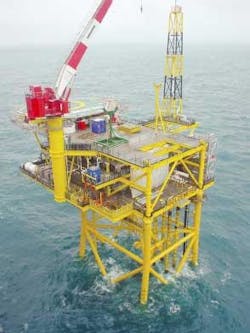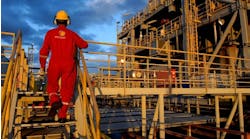Field developments back in vogue
Development work is picking up pace across the North Sea, with five new projects under way last month alone. The largest in terms of scope and investment are both in the Norwegian North Sea.
Marathon’s NKr9.2 billion Alvheim scheme aims to extract 180 MMboe from three accumulations known as Kameleon, Kneler, and Boa, the latter extending into UK waters. All three will be tied back to an FPSO, a conversion of the former Navion-owned shuttle tankerOdin, through five separate drill centers. The vessel will store 560,000 bbl of oil, with gas sent west to the UK via a new 14-in. pipeline connecting to the SAGE system. First oil is due by spring 2007, with production climbing swiftly to a peak of 50,000 b/d.
Norsk Hydro’s nearby Vilje discovery - previously named Klegg - may also be tied in. A development submission for this field is expected shortly.
Hydro has secured approval from its partners in the Oseberg license for a NKr1.9-billion upgrade of the Oseberg East platform starting in January and continuing through fall 2006. Hydro will drill seven new wells and will implement various process changes, the twin aim being to increase recovery by an extra 40 MMbbl and to extend the platform’s service life. The upgrade will include installation of a new drilling fluid module with attendant generator and transformer, a new loading deck for drilling equipment and chemicals, and a new process control system to meet Norwegian stipulations concerning zero discharges of drilling waste and pollutant liquids.
The goldeneye platform is in the Outer Moray Firth.
null
In the far north of the UK shelf, BP has announced a £130-million program to access up to 40 MMbbl of extra oil from the Magnus area. The Magnus field, in block 211/2a northeast of the Shetlands, came onstream in 1983 through a fixed platform. This facility still produces around 48,000 boe/d, thanks in large part to the recently installed Magnus Enhanced Oil Recovery pipeline, which imports lift-gas from BP’s fields west of the Shetlands.
The new scheme, known as the Magnus Extension Project, will involve modifications to the platform, including additional well slots. These will allow a further eight development wells to be drilled during a continuous spell between end-2005 and mid-2008. Rig alterations, to enable extended reach drilling, will be implemented shortly. BP has also issued subsea hardware contracts for Farragon, a two-well tieback in the Central North Sea to its Andrew platform. The trees, controls, and umbilical contracts have gone respectively to Cameron, Vetco Gray, and Aker-Kværner, with KBR handling topsides modifications on Andrew.
At the southern end of the North Sea, Tullow Oil was expecting government sanction for its first operated UK continental shelf developments, Horne and Wren, in blocks 53/3c and 53/4b. Fabrication of the fields’ shared minimum facilities platform is already well advanced. This will be tied back in turn to the Thames Offshore infrastructure, in which Tullow is a two-thirds partner. Gas from single wells on each field will be exported to the Thames AR platform through a 20-km long, 10-in. production flowline with a piggybacked 2-in. corrosion/hydrate inhibitor line, Saipem will install early next year.
Tullow has also reached agreement with Mobil North Sea and EOG resources to take gas from the Arthur field discovery in block 53/2 via the same infrastructure. Arthur should be onstream by year-end, with Horne and Wren in start-up mode by mid-2005. All three fields will increase the Thames area throughput by over 150 MMcf/d - processed gas is sent to the terminal in Bacton on the Norfolk coast.
Three significant UK sector projects have also come onstream. Shell’s Goldeneye is situated in a previously undeveloped part of the Outer Moray Firth. Gas and condensate produced to the platform is being transferred at reservoir pressure directly to the processing plant at St Fergus, via a 105-km pipeline. Goldeneye will supply 3% of the UK’s gas demand. Burlington’s five-field Rivers development in the Irish Sea is producing gas through the Calder field platform. Centrica has since assumed operating control of this facility - gas is being piped to a new terminal in Barrow, northwest England. Finally, ChevronTexaco has delivered first oil from its subsea Alba Extreme South Phase 2 project in the central North Sea. The semisubmersibleStena Spey drilled three new production wells this year. They are already flowing peak output of 40,000 b/d to the Alba platform.
Shell cleared to revive Corrib
Ireland’s first subsea-shore development looks to be back on track following an enforced break. Progress on the Corrib gas field 75 km west of County Mayo on the west coast, had stalled due to planning difficulties associated with the land-based process terminal. Although the county council had approved original operator Enterprise Oil’s proposal, appeals body An Bord Pleanala later rejected it following concerns over peat bog excavations.
New operator Shell, which acquired Enterprise in 2002, then commissioned new technical studies, which found that construction could be managed without causing serious environmental damage. Both the council and An Bord Plenala recently endorsed these findings, leaving Shell free to pursue its plans to build a terminal at Bellanaboy Bridge, and an associated peat deposition site at Strahmore. Unless a further judicial review is mounted, construction should start by year-end, leading to first gas production in spring 2007.
Corrib is a 1 tcf field in 350 m of water. It remains Ireland’s sole commercial discovery away from the Celtic Sea to the south. The gas will be produced through remotely operated wells on the seabed and transported through an 85-km subsea pipeline to Dooncarton in Broadhaven Bay. From this point, supplies will be piped 9-km though a buried onshore section to Bellanaboy Bridge. At peak, the process plant will handle 350 MMcf/d, which Shell believes could supply 60% of Ireland’s annual needs.




